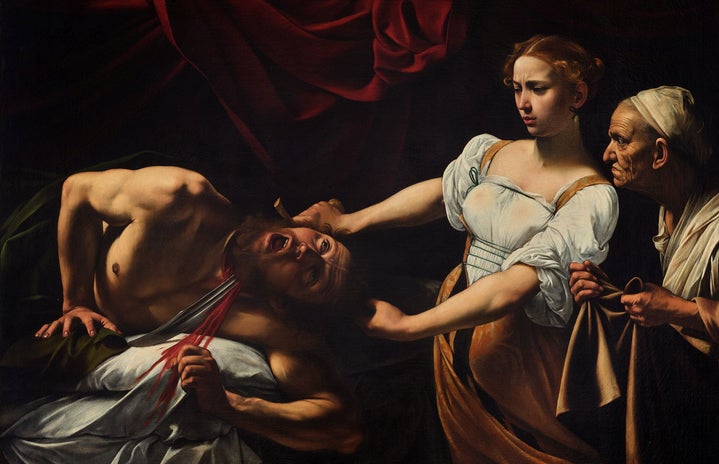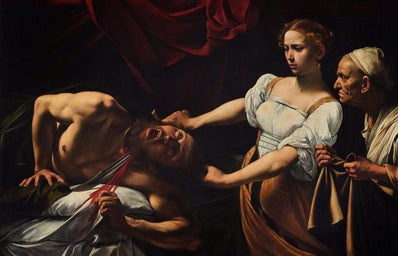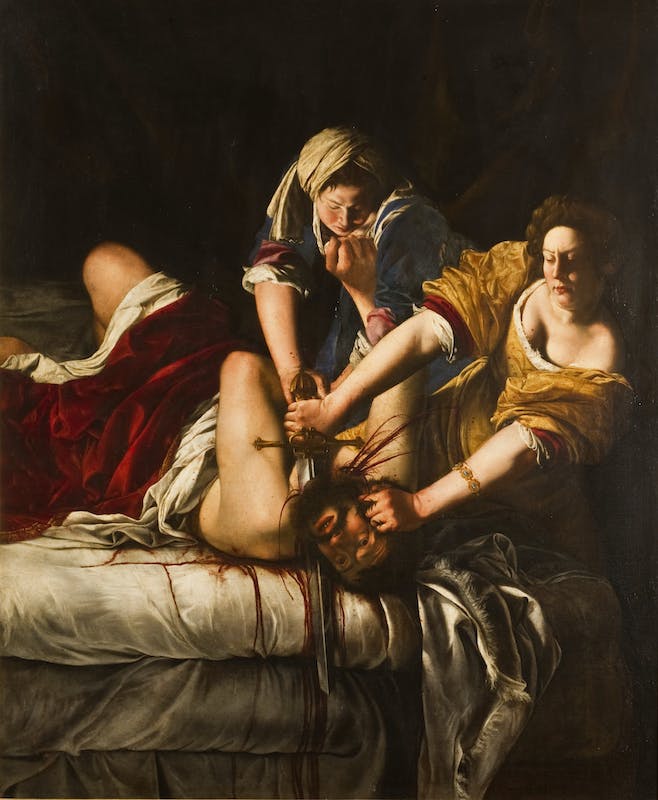The tale of the heroic warrior woman — tainted by the pen of men.
Let’s travel back 2,000 years. The legendary Book of Judith (100 B.C.) centers around a Jewish widow who brings victory to her people by killing the Assyrian general Holofernes after he lays siege upon Bethulia. Scholars have debated the level of fact and fiction in the book for centuries. Nevertheless, the story persisted. The poem Judith was written sometime between 793 and 1016 to inspire Anglo-Saxons to fight back against the Vikings.
Regardless of whether Judith was a real person — or if she was inspired by another woman of the time — her name remains recognizable. Written during a period when most literature followed male heroes, Judith is an important figure across literature, art, and religion. In the wake of historical retellings taking the publishing industry by storm, we must consider one of the first depictions of a woman moving beyond the realm of traditional femininity.
The book of judith
The Book of Judith describes General Holofernes plundering various cities to bring them into King Nabuchodonosor’s empire. Judith is not introduced until her town, Bethulia, is attacked. The author describes Judith as a widow left with great riches from her dead husband. She is holy, fearful of God, and exceedingly beautiful. Judith, who plans to kill Holofernes, beseeches God to grant her strength. At one point, she says, “This will be a glorious moment for thy name, when he shall fall by the hand of a woman.” Judith insults her womanhood to appease God. He rewards her words by increasing her beauty “so that she appeared to all men’s eyes incomparably lovely.”
Later, Holofernes is mesmerized by Judith’s beauty. He tells his men to “persuade that Hebrew woman, to consent of her own accord to dwell with me.” Judith complies, playing the part of a submissive woman. When Holofernes becomes drunk and passes out, Judith asks God for strength again and decapitates the general in two strikes. Judith takes his head and inspires her people with a speech where she credits God for killing Holofernes. She says, “he hath killed the enemy of his people by my hand this night.” Thus, Judith is diminished to a mere vessel used to carry out His will. For her role, Judith is rewarded with gold and household items — a starch reminder of her place in society. She lives as a chaste widow for the rest of her life, and her courage goes unacknowledged.
“The problems in Judith and the Book of Judith stem from the diction of the authors, not from the heart of the story itself.”
Judith, the Poem
Judith begins with Holofernes’ feast, where the general overindulges in wine. Eventually, he commands Judith to be brought to his bed. Holofernes intends “to violate the bright woman with defilement and with sin.” This diction is different from the Book of Judith, where Holofernes (somewhat) desires her consent. By God’s will, Holofernes passes out from drinking before this can happen. Judith seizes this opportunity and calls on God to grant her victory in a long, flattering speech. Then, she decapitates Holofernes.
Similar to the Book of Judith, Judith’s act fulfills God’s will, and her success is attributed to God providing her with the necessary strength. Judith is an instrument of the patriarchy, God, and could not have killed Holofernes with her own strength. While baring Holferne’s head to the people of Bethulia, Judith announces that she “deprived him of life through God’s help.” The word “through” is a crucial piece of diction. If Judith had declared that “I deprived him of life with God’s help” then the power and purpose behind the action would have been shifted to herself.
The death of Holofernes inspires the Hebrew people. With Judith’s council, they are victorious against the Assyrians in battle, and she is rewarded with the sword of Holofernes, his helmet and mail coat, and all his treasures. Judith is celebrated by her people for killing Holofernes, as well as for her council in battle. The act of giving her Holofernes’ battle armor, instead of household items, raises Judith, a woman, to the level of a warrior. The poem ends with the poet attributing the victory to Judith as a result of her true faith in God. This ending shows men praising a woman for exhibiting stereotypically masculine traits.
Women written by men
It’s easy for the Book of Judith and Judith to be labeled as feminist texts; after all, they were composed during a time when male knights, monks, and kings dominated literature. However, Judith represents a man’s idealized version of a warrior-woman in both sources. While Judith is praised for her masculine act of violence, she is written to have an excess of societal-conforming feminine traits that make this act acceptable.
This trope, which persisted hundreds of years past Judith, is described by Nancy Armstrong in her 2006 study. Armstrong writes that heroines must appear rational and resourceful before they overcome gender bias and “achieve recognition within the community that appears progressive for letting her extend the limits of acceptable feminine behavior.” (This trope still persists in movies, books, and TV shows.)
In the poem, Judith possesses “elfin beauty” and “true faith in the Almighty.” The poet also uses diction such as “blessed maiden,” “noble,” “bright,” and “holy maiden” when referring to Judith, emphasizing her purity and faithfulness to God. The Book of Judith emphasizes Judith’s chastity and irresistible beauty as well. All these traits were expected of women during her time. Judith’s moment of masculinity, where she contests social norms, is acceptable because of this excess of positive, admirable traits. Judith is written to portray the ideal model of a woman, and her displays of masculinity are confined to acceptable limits.
Conclusion
Despite the patriarchal themes in both the poem and book, Judith should not be dismissed. Stripped to its barest bones, the story of Judith describes a brave woman utilizing the power of her sexuality to weaken General Holofernes. She then decapitates him and transforms his death into a rallying symbol that saves her people. Judith’s story is not anti-feminist; it is both heroic and inspiring.
Conflict occurs because both authors diminish Judith’s power as a woman by incorporating themes of patriarchy, such as declaring a masculine God as the true hero and emphasizing her chastity and submissiveness to God. A contemporary female author could retell this story as a heroic feminist tale — the tale that’s practically begging to be unleashed — without erasing its religious message. The problems in Judith and the Book of Judith stem from the diction of the authors, not from the heart of the story itself.
This article is part of #FeminsimUncovered, a series created by Chloe E. Hummel to tell the remarkable stories of women erased by history.



